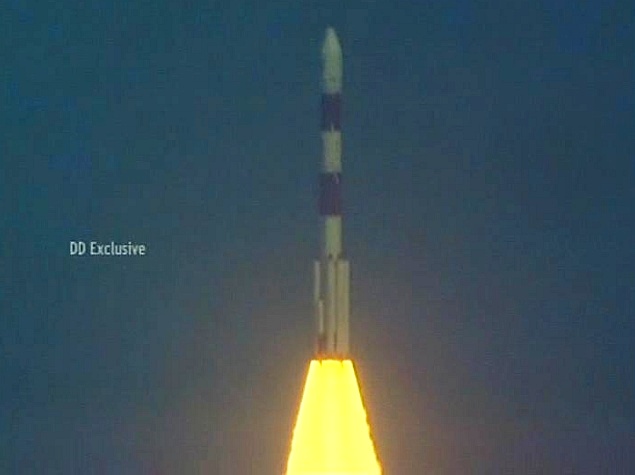- Home
- Others
- Others News
- India's Mars Orbiter Mission blasts off successfully
India's Mars Orbiter Mission blasts off successfully
By Agence France-Presse | Updated: 5 November 2013 15:33 IST

Click Here to Add Gadgets360 As A Trusted Source

Advertisement
India's first mission to Mars blasted off on Tuesday as the country aims to become the only Asian nation to reach the Red Planet with a programme showcasing its low-cost space technology.
"It's lift off," said a commentator on state television as the red-and-black rocket launched into a slightly overcast sky on schedule at 02:38pm (0908 GMT) from the southern spaceport in Sriharikota.
The 350-tonne launch vehicle carrying an unmanned probe was monitored by dozens of scientists in the control room who face their most daunting task since India began its space programme in 1963.
The country has never before attempted inter-planetary travel and more than half of all missions to Mars have ended in failure, including China's in 2011 and Japan's in 2003.
The Mars Orbiter Mission, known as "Mangalyaan" in India, was announced only 15 months ago by Prime Minister Manmohan Singh, shortly after China's attempt flopped when it failed to leave Earth's atmosphere.
The timing led to speculation that India was seeking to make a point to its militarily and economically superior neighbour, despite denials from the country's space agency.
"We are in competition with ourselves in the areas that we have charted for ourselves," Indian Space Research Organisation (ISRO) chairman K. Radhakrishnan told AFP last week.
The gold-coloured probe, the size of a small car, will aim to detect methane in the Martian atmosphere. It has been hurriedly assembled and is being carried by a rocket much smaller than US or Russian equivalents.
Lacking the power to fly directly, the launch vehicle will orbit Earth for nearly a month, building up the necessary velocity to break free from our planet's gravitational pull.
Only then will it begin the second stage of its nine-month journey which will test India's scientists to the full, five years after they sent a probe called Chandrayaan to the moon.
The cost of the Mars mission is 4.5 billion rupees ($73 million), less than a sixth of the 455 million dollars earmarked for a Mars probe by NASA which will launched later this month.
"We didn't believe they'd be able to launch this early," project scientist for the NASA Mars probe, Joe Grebowsky, told AFP. "If it's successful, it's fantastic."
He underlined that Mars, which has a complicated orbit meaning it is between 50-400 million kilometres from Earth, was a far more complex prospect compared with a moon mission.
"When you shoot a rocket at Mars you have to take into account that Mars is going to move a good deal before you get there. The moon is fairly close," he said.
There have been recent setbacks for India too, including when Chandrayaan lost contact with its controllers in 2009. Another launch vehicle blew up after take-off in 2010.
The programme also has to contend with critics who say a country that struggles to feed its people adequately and where more than half have no toilets should not be splurging on space travel.
ISRO counters that its technology has helped economic development through satellites which monitor weather and water resources, or enable communication in remote areas.
The Bangalore-based organisation and its 16,000 staff also share their rocket technology with the state-run defence body responsible for India's missile programme.
The United States is the only nation that has successfully sent robotic explorers to land on Mars, the most recent being Curiosity which touched down in August 2012.
One of its discoveries appeared to undercut the purpose of the Indian mission which is to find evidence of methane which would lend credence to the idea of Mars supporting a primitive form of life.
A study of data from Curiosity published in September found the rover had detected only trace elements of methane in the atmosphere.
"Remember that it (Curiosity's methane reading) is for a single spot. One point doesn't make it a story for the whole planet," top Indian space scientist Jitendra Nath Goswami told AFP.
NASA, which will launch its Maven probe on November 18 to study why Mars lost its atmosphere, is helping ISRO with communications.
Clouds of methane have previously been identified by telescopes on Mars, but the gas has never been confirmed by a mission there.
Methane on Earth is mostly produced by micro-organisms, so a positive reading would suggest some form of life on a planet that scientists believe was once covered with water.
"It's lift off," said a commentator on state television as the red-and-black rocket launched into a slightly overcast sky on schedule at 02:38pm (0908 GMT) from the southern spaceport in Sriharikota.
The 350-tonne launch vehicle carrying an unmanned probe was monitored by dozens of scientists in the control room who face their most daunting task since India began its space programme in 1963.
The country has never before attempted inter-planetary travel and more than half of all missions to Mars have ended in failure, including China's in 2011 and Japan's in 2003.
The Mars Orbiter Mission, known as "Mangalyaan" in India, was announced only 15 months ago by Prime Minister Manmohan Singh, shortly after China's attempt flopped when it failed to leave Earth's atmosphere.
The timing led to speculation that India was seeking to make a point to its militarily and economically superior neighbour, despite denials from the country's space agency.
"We are in competition with ourselves in the areas that we have charted for ourselves," Indian Space Research Organisation (ISRO) chairman K. Radhakrishnan told AFP last week.
The gold-coloured probe, the size of a small car, will aim to detect methane in the Martian atmosphere. It has been hurriedly assembled and is being carried by a rocket much smaller than US or Russian equivalents.
Lacking the power to fly directly, the launch vehicle will orbit Earth for nearly a month, building up the necessary velocity to break free from our planet's gravitational pull.
Only then will it begin the second stage of its nine-month journey which will test India's scientists to the full, five years after they sent a probe called Chandrayaan to the moon.
The cost of the Mars mission is 4.5 billion rupees ($73 million), less than a sixth of the 455 million dollars earmarked for a Mars probe by NASA which will launched later this month.
"We didn't believe they'd be able to launch this early," project scientist for the NASA Mars probe, Joe Grebowsky, told AFP. "If it's successful, it's fantastic."
He underlined that Mars, which has a complicated orbit meaning it is between 50-400 million kilometres from Earth, was a far more complex prospect compared with a moon mission.
"When you shoot a rocket at Mars you have to take into account that Mars is going to move a good deal before you get there. The moon is fairly close," he said.
There have been recent setbacks for India too, including when Chandrayaan lost contact with its controllers in 2009. Another launch vehicle blew up after take-off in 2010.
The programme also has to contend with critics who say a country that struggles to feed its people adequately and where more than half have no toilets should not be splurging on space travel.
ISRO counters that its technology has helped economic development through satellites which monitor weather and water resources, or enable communication in remote areas.
The Bangalore-based organisation and its 16,000 staff also share their rocket technology with the state-run defence body responsible for India's missile programme.
The United States is the only nation that has successfully sent robotic explorers to land on Mars, the most recent being Curiosity which touched down in August 2012.
One of its discoveries appeared to undercut the purpose of the Indian mission which is to find evidence of methane which would lend credence to the idea of Mars supporting a primitive form of life.
A study of data from Curiosity published in September found the rover had detected only trace elements of methane in the atmosphere.
"Remember that it (Curiosity's methane reading) is for a single spot. One point doesn't make it a story for the whole planet," top Indian space scientist Jitendra Nath Goswami told AFP.
NASA, which will launch its Maven probe on November 18 to study why Mars lost its atmosphere, is helping ISRO with communications.
Clouds of methane have previously been identified by telescopes on Mars, but the gas has never been confirmed by a mission there.
Methane on Earth is mostly produced by micro-organisms, so a positive reading would suggest some form of life on a planet that scientists believe was once covered with water.
Comments
Catch the latest from the Consumer Electronics Show on Gadgets 360, at our CES 2026 hub.
Further reading:
ISRO, Indian Mars Orbiter Mission, Indian Space Research Organisation, Mangalyaan, Mars, Mars Orbiter Mission, PSLV C25
Related Stories
Popular on Gadgets
- Samsung Galaxy Unpacked 2025
- ChatGPT
- Redmi Note 14 Pro+
- iPhone 16
- Apple Vision Pro
- Oneplus 12
- OnePlus Nord CE 3 Lite 5G
- iPhone 13
- Xiaomi 14 Pro
- Oppo Find N3
- Tecno Spark Go (2023)
- Realme V30
- Best Phones Under 25000
- Samsung Galaxy S24 Series
- Cryptocurrency
- iQoo 12
- Samsung Galaxy S24 Ultra
- Giottus
- Samsung Galaxy Z Flip 5
- Apple 'Scary Fast'
- Housefull 5
- GoPro Hero 12 Black Review
- Invincible Season 2
- JioGlass
- HD Ready TV
- Laptop Under 50000
- Smartwatch Under 10000
- Latest Mobile Phones
- Compare Phones
Latest Gadgets
- OPPO Reno 15 Pro Max
- Honor Win RT
- Honor Win
- Xiaomi 17 Ultra Leica Edition
- Xiaomi 17 Ultra
- Huawei Nova 15
- Huawei Nova 15 Pro
- Huawei Nova 15 Ultra
- Asus ProArt P16
- MacBook Pro 14-inch (M5, 2025)
- OPPO Pad Air 5
- Huawei MatePad 11.5 (2026)
- Xiaomi Watch 5
- Huawei Watch 10th Anniversary Edition
- Acerpure Nitro Z Series 100-inch QLED TV
- Samsung 43 Inch LED Ultra HD (4K) Smart TV (UA43UE81AFULXL)
- Asus ROG Ally
- Nintendo Switch Lite
- Haier 1.6 Ton 5 Star Inverter Split AC (HSU19G-MZAID5BN-INV)
- Haier 1.6 Ton 5 Star Inverter Split AC (HSU19G-MZAIM5BN-INV)
© Copyright Red Pixels Ventures Limited 2026. All rights reserved.
















